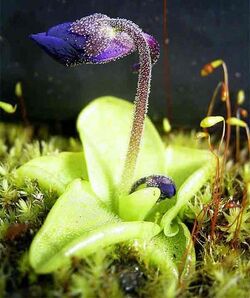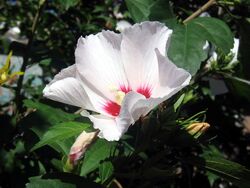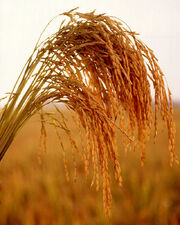
Pinguicula grandiflora
Botany is the scientific study of plantlife. As a branch of biology, it is also sometimes referred to as plant science(s) or plant biology. Botany covers a wide range of scientific disciplines that study the structure, growth, reproduction, metabolism, development and diseases of plants. The study of plants and botany began with tribal lore, used to identify edible, medicinal and poisonous plants, making botany one of the oldest sciences. From this the scope of botany has increased to include the study of over 550,000 kinds or species of living organisms.
Scope and importance of botany

Hibiscus
As with other life forms in biology, plant life can be studied from different perspectives, from the molecular, genetic and biochemical level through organelles, cells, tissues, organs, individuals, plant populations, and communities of plants. At each of these levels a botanist might be concerned with the classification (taxonomy), structure (anatomy), or function (physiology) of plant life.
Historically, botany covers all organisms that were not considered to be animals. Some of these "plant-like" organisms include fungi (studied in mycology), bacteria and viruses (studied in microbiology), and algae (studied in phycology). Most algae, fungi, and microbes are no longer considered to be in the plant kingdom. However, attention is still given to them by botanists, and bacteria, fungi, and algae are usually covered in introductory botany courses.
The study of plants is important for a number of reasons. Plants are a fundamental part of life on earth. They generate the oxygen, food, fibres, fuel and medicine that allow higher life forms to exist. Plants also absorb carbon dioxide, a significant greenhouse gas, through photosynthesis. A good understanding of plants is crucial to the future of human societies as it allows us to:
- Feed the world
- Understand fundamental life processes
- Utilise medicine and materials
- Understand environmental changes
Human nutrition

Nearly all the food we eat comes (directly and indirectly) from plants like this American long grain rice.
Virtually all food eaten comes from plants, either directly from staple foods and other fruit and vegetables, or indirectly through livestock or other animals, which rely on plants for their nutrition. In other words, plants are at the base of nearly all food chains, or what ecologists call the first trophic level. Understanding how plants produce the food we eat is therefore important to be able to feed the world and provide food security for future generations, for example through plant breeding. Not all plants are beneficial to humans, some weeds are a considerable problem in agriculture and botany provides some of the basic science in order to understand how to minimise their impact. However, other weeds are pioneer plants which start an abused environment back on the road to rehabilitation, underlining that the term 'weed' is a very relative concept, and that broadly defined a weed is simply a plant which is too successful. Ethnobotany is the study of this and/or other relationships between plants and people.

Gregor Mendel laid the foundations of genetics from his studies of plants.
Fundamental life processes
Plants are convenient organisms in which fundamental life processes (like cell division and protein synthesis for example) can be studied, without the ethical dilemmas of studying animals or humans. The genetic laws of inheritance were discovered in this way by Gregor Mendel, who was studying the way pea shape is inherited. What Mendel learnt from studying plants has had far reaching benefits outside of botany. Additionally, Barbara McClintock discovered 'jumping genes' by studying maize. These are a few examples that demonstrate how botanical research has an ongoing relevance to the understanding of fundamental biological processes.
Medicine and materials
Many medicinal and recreational drugs, like cannabis, caffeine, and nicotine come directly from the plant kingdom. Aspirin, which originally came from the bark of willow trees, is just one example. There may be many novel cures for diseases provided by plants, waiting to be discovered. Popular stimulants like coffee, chocolate, tobacco, and tea also come from plants. Most alcoholic beverages come from fermenting plants such as barley malt and grapes.
Plants also provide us with many natural materials, such as cotton, wood, paper, linen, vegetable oils, some types of rope, and rubber. The production of silk would not be possible without the cultivation of the mulberry plant. Sugarcane and other plants have recently been put to use as sources of biofuels, which are important alternatives to fossil fuels.
Environmental changes
Plants can also help us understand changes in on our environment in many ways.
- Understanding habitat destruction and species extinction is dependent on an accurate and complete catalogue of plant systematics and taxonomy.
- Plant responses to ultraviolet radiation can help us monitor problems like the ozone depletion.
- Analysing pollen deposited by plants thousands or millions of years ago can help scientists to reconstruct past climates and predict future ones, an essential part of climate change research.
- Recording and analysing the timing of plant life cycles are important parts of phenology used in climate-change research.
- Lichens, which are sensitive to atmospheric conditions, have been extensively used as pollution indicators.
In many different ways, plants can act a little like the 'miners canary', an early warning system alerting us to important changes in our environment. In addition to these practical and scientific reasons, plants are extremely valuable as recreation for millions of people who enjoy gardening, horticultural and culinary uses of plants every day.
History
Early botany (before 1945)

The traditional tools of a botanist.
Among the earliest of botanical works, written around 300 B.C., are two large treatises by Theophrastus: On the History of Plants (Historia Plantarum) and On the Causes of Plants. Together these books constitute the most important contribution to botanical science during antiquity and on into the Middle Ages. The Roman medical writer Dioscorides provides important evidence on Greek and Roman knowledge of medicinal plants.
In 1665, using an early microscope, Robert Hooke discovered cells in cork, a short time later in living plant tissue. The German Leonhart Fuchs, the Swiss Conrad von Gesner, and the British authors Nicholas Culpeper and John Gerard published herbals that gave information on the medicinal uses of plants.
Modern botany (since 1945)
A considerable amount of new knowledge today is being generated from studying model plants like Arabidopsis thaliana. This mustard weed was one of the first plants to have its genome sequenced. The sequencing of the rice genome and a large international research community have made rice the de facto cereal/grass/monocot model. Another grass species, Brachypodium distachyon is also emerging as an experimental model for understanding the genetic, cellular and molecular biology of temperate grasses. Other commercially important staple foods like wheat, maize, barley, rye, millet and soybean are also having their genomes sequenced. Some of these are challenging to sequence because they have more than two haploid (n) sets of chromosomes, a condition known as polyploidy, common in the plant kingdom. The "Green Yeast" Chlamydomonas reinhardtii (a single-celled, green alga) is another plant model organism that has been extensively studied and provided important insights into cell biology.
See also

Crantz's Classis cruciformium..., 1769
- History of plant systematics
- Botanical garden and List of botanical gardens
- Dendrochronology
- List of domesticated plants
- Edible Flowers
- Flowers and List of flowers
- Forestry
- Herbs
- List of botanical journals
- List of botanists
- List of botanists by author abbreviation
- List of publications in biology
- Paleobotany
- Palynology
- Plant anatomy
- Plant physiology
- Plant community
- Plant sexuality
- Soil science
- Trees
- Vegetation
References
- U.S. Geological Survey. National Biological Information Infrastructure: Botany
Further reading
Popular science style books on Botany
- Attenborough, David The Private Life of Plants, ISBN 0-563-37023-8
- Bellamy, D Bellamy on Botany, ISBN 0-563-10666-2 an accessible and short introduction to various botanical subjects
- Capon, B: Botany for Gardeners ISBN 0-88192-655-8
- Cohen, J. How many people can the earth support? W.W. Norton 1995 ISBN 0-393-31495-2
- Halle, Francis. In praise of plants ISBN 0-88192-550-0. English translation of a poetic advocacy of plants.
- King, J. Reaching for the sun: How plants work ISBN 0-521-58738-7. A fluent introduction to how plants work.
- Pakenham, T: Remarkable Trees of the World (2002) ISBN 0-297-84300-1
- Pakenham, T: Meetings with Remarkable Trees (1996) ISBN 0-297-83255-7
- Pollan, M The Botany of Desire: A Plant's-eye View of the World Bloomsbury ISBN 0-7475-6300-4 Account of the co-evolution of plants and humans
- Thomas, B.A.: The evolution of plants and flowers St Martin's Press 1981 ISBN 0-312-27271-5
- Walker, D. Energy, Plants and Man ISBN 1-870232-05-4 A presentation of the basic concepts of photosynthesis
Academic and Scientific books on Botany
- Buchanan, B.B., Gruissem, W & Jones, R.L. (2000) Biochemistry & molecular biology of plants. American Society of Plant Physiologists ISBN 0-943088-39-9
- Crawford, R. M. M. (1989). Studies in plant survival. Blackwell. ISBN 0-632-01475-X
- Crawley, M. J. (1997). Plant ecology. Blackwell Scientific. ISBN 0-632-03639-7
- Ennos, R and Sheffield, E Plant life, Blackwell Science, ISBN 0-86542-737-2 Introduction to plant biodiversity
- Fitter, A & Hay, R Environmental physiology of plants 3rd edition Sept 2001 Harcourt Publishers, Academic Press ISBN 0-12-257766-3
- Lambers, H., Chapin, F.S. III and Pons, T.L. 1998. Plant Physiological Ecology. Springer-Verlag, New York. ISBN 0-387-98326-0
- Lawlor, D.W. (2000) Photosynthesis BIOS ISBN 1-85996-157-6
- Matthews, R. E. F. Fundamentals of plant virology Academic Press,1992.
- Mauseth, J.D.: Botany : an introduction to plant biology. Jones and Bartlett Publishers, ISBN 0-7637-2134-4, A first year undergraduate level textbook
- Raven, P.H, Evert R.H and Eichhorn, S.E: Biology of Plants, Freeman. ISBN 1-57259-041-6, A first year undergraduate level textbook
- Richards, P. W. (1996). The tropical rainforest. 2nd ed. C.U.P. (Pbk) ISBN 0-521-42194-2 £32.50
- Ridge, I. (2002) Plants Oxford University Press ISBN 0-19-925548-2
- Salisbury, FB and Ross, CW: Plant physiology Wadsworth publishing company ISBN 0-534-15162-0
- Stace, C. A. A new flora of the British Isles. 2nd ed. C.U.P.,1997. ISBN 0-521-58935-5
- Strange, R. L. Introduction to plant pathology. Wiley-VCH, 2003. ISBN 0-470-84973-8
- Taiz, L. & Zeiger, E. (1998). Plant physiology. 3rd ed. August 2002 Sinauer Associates. ISBN 0-87893-823-0
- Walter, H. (1985). Vegetation of the earth. 3rd rev. ed. Springer.
- Willis, K (2002) The evolution of plants Oxford University Press ISBN 0-19-850065-3 £22-99
External links
- Hunt Institute for Botanical Documentation
- Torner Watercolors c. 1700, from Mexican Expedition. All 2000+ Watercolors for free viewing Courtesy the Hunt Institute and the Universal Library at Carnegie-Mellon University
- plant growth and the plant cell from Kimball's Biology Pages
- Biology News Headlines,
- Botanical Society of America: What is Botany?
- Science and Plants for Schools
- Teaching Documents about Botany Teaching documents, lecture notes and tutorials online: an annotated link directory.
- American society of plant biologists APSB
- Why study Plants? Dept of Plant Sciences, University of Cambridge
- Botany Photo of the Day
Flora and other plant catalogues or databases
- The Virtual Library of Botany
- List of major natural Plant Species in the UK, described in the National Vegetation Classification
- High quality pictures of plants and information about them from Catholic University of Leuven
- Curtis's Botanical Magazine, 1790-1856
- The Trees Of Great Britain and Ireland, by Henry John Elwes & Augustine Henry, 1906-1913
- Botanik-Datenbank (ger.)
- Plant Directory (ger.)
- USDA plant database
| Anatomy | Astrobiology | Biochemistry | Bioinformatics | Botany | Cell biology | Ecology | Developmental biology | Evolutionary biology | Genetics | Genomics | Marine biology | Human biology | Microbiology | Molecular biology | Origin of life | Paleontology | Parasitology | Pathology | Physiology | Taxonomy | Zoology |

|
This page uses content from Wikipedia. The original article was at Botany. The list of authors can be seen in the page history. As with Paleontology Wiki, the text of Wikipedia is available under the GNU Free Documentation License. |